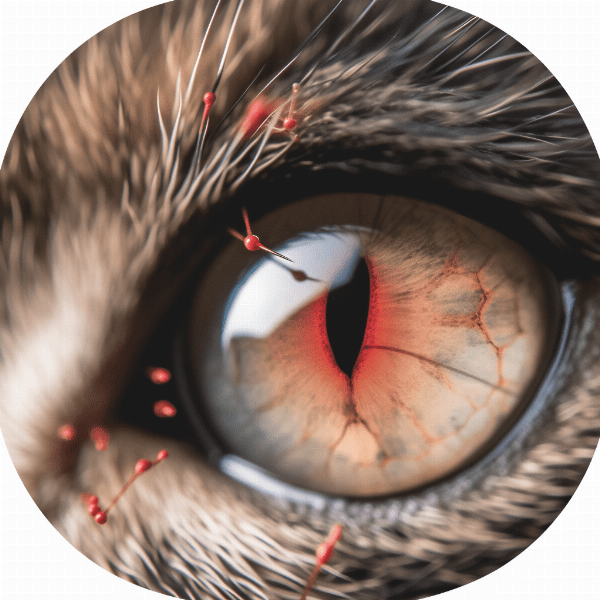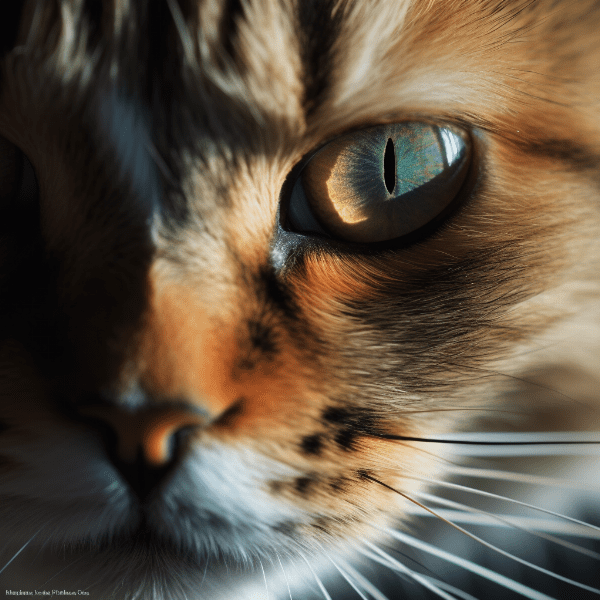Table of Contents
- Understanding Persian Cat Eye Infections
- Recognizing the Symptoms of Eye Infections in Persian Cats
- Causes of Eye Infections in Persian Cats
- Prevention of Persian Cat Eye Infections
- Diagnosis and Treatment of Persian Cat Eye Infections
- Home Remedies for Persian Cat Eye Infections
- When to See a Vet for Your Persian Cat’s Eye Infection
- Caring for Your Persian Cat After an Eye Infection
- Conclusion and Final Tips for Preventing Persian Cat Eye Infections.
Understanding Persian Cat Eye Infections
If you own a Persian cat, you know that these cats have stunning eyes. However, just like with any other cat breed, they are prone to eye infections. Understanding the nature of Persian cat eye infections is important for every cat owner. In this section, we’ll discuss what causes these infections, what their symptoms are, and how they can be treated.
Causes of Persian Cat Eye Infections
Persian cats’ eyes are more prone to infections because of their distinctive features. For example, their flat faces and shortened noses make it difficult for them to drain tears properly. This often leads to the accumulation of tears around the eyes, providing a breeding ground for bacteria and viruses.
Another cause of Persian cat eye infections is genetics. Some cats may be predisposed to eye infections due to their genetic makeup. Additionally, environmental factors such as exposure to dust, pollen, or other irritants can also cause infections in Persian cats.
Symptoms of Persian Cat Eye Infections
One of the most common symptoms of a Persian cat eye infection is excessive tearing. You may also notice redness around the eyes, discharge, and a change in the color of the iris. In some cases, Persian cats may also experience swelling around the eyes or sensitivity to light.
How Persian Cat Eye Infections are Treated
Treating Persian cat eye infections usually involves medication, but the type of medication will depend on the severity of the infection. Antibiotics may be prescribed to treat bacterial infections, while antiviral medications may be used to treat viral infections.
In some cases, home remedies such as warm compresses or eye drops may be effective in treating mild infections. However, it’s important to consult with a veterinarian before trying any home remedies.
Overall, understanding Persian cat eye infections is crucial for the health and wellbeing of your feline friend. By recognizing the symptoms and seeking treatment early on, you can prevent further complications and help your cat recover quickly.

Recognizing the Symptoms of Eye Infections in Persian Cats
As a Persian cat owner, it’s important to be able to recognize the symptoms of eye infections in your furry friend. The earlier you can identify an infection, the sooner you can seek treatment and prevent any complications. In this section, we’ll discuss the common symptoms of Persian cat eye infections and what they might indicate.
Excessive Tearing
Excessive tearing is one of the most common symptoms of an eye infection in Persian cats. If you notice your cat’s eyes watering more than usual, or if there is a buildup of tears around the eyes, it could be a sign of an infection. Excessive tearing can be caused by a blocked tear duct or by irritation and inflammation in the eye.
Redness and Swelling
Another common symptom of an eye infection in Persian cats is redness and swelling around the eyes. If your cat’s eyes appear swollen, puffy, or red, it may indicate an infection. Swelling and redness can be caused by a range of factors, including inflammation, allergies, or infection.
Discharge
Eye discharge is another symptom of an eye infection in Persian cats. If you notice any discharge around your cat’s eyes, it’s important to examine it carefully. The color, consistency, and odor of the discharge can help your veterinarian determine the cause of the infection. Some infections may produce a thick, yellow or greenish discharge, while others may produce a clear or watery discharge.
Changes in Behavior
If your Persian cat is experiencing discomfort or pain from an eye infection, you may notice changes in their behavior. They may be more lethargic or less interested in playing or eating. They may also rub or scratch their eyes, indicating that they are experiencing irritation or discomfort.
Sensitivity to Light
Sensitivity to light, also known as photophobia, is another symptom of an eye infection in Persian cats. If your cat is avoiding bright lights or appears to be in discomfort when exposed to light, it may indicate an infection. Photophobia can be caused by inflammation or infection in the eye, and it’s important to seek treatment as soon as possible.
In conclusion, recognizing the symptoms of eye infections in Persian cats is crucial for early detection and treatment. If you notice any of these symptoms in your cat, it’s important to consult with a veterinarian as soon as possible to prevent any complications and ensure the health and well-being of your furry friend.

Causes of Eye Infections in Persian Cats
Eye infections in Persian cats can be caused by a variety of factors. In this section, we’ll discuss the different causes of eye infections in Persian cats and how they can be prevented.
Congenital Defects
Some Persian cats may be born with congenital defects that make them more susceptible to eye infections. These defects can include abnormalities in the tear ducts or eyelids, which can make it difficult for tears to drain properly and increase the risk of infection.
Allergies
Just like humans, cats can also develop allergies. Allergies in Persian cats can be caused by a range of factors, including food, environmental irritants, or even grooming products. Allergies can cause irritation and inflammation in the eyes, making them more prone to infections.
Viral and Bacterial Infections
Viral and bacterial infections can also cause eye infections in Persian cats. These infections can be spread through direct contact with other infected cats, or through contaminated objects such as food bowls or toys. Bacterial infections can cause discharge, swelling, and redness in the eyes, while viral infections can cause more severe symptoms such as fever, lethargy, and loss of appetite.
Trauma
Trauma to the eye or head can also cause eye infections in Persian cats. This can include scratches, bites, or injuries from falls or accidents. Trauma can cause inflammation and damage to the eye, making it more vulnerable to infection.
Environmental Factors
Environmental factors such as dust, pollen, or smoke can also contribute to eye infections in Persian cats. These irritants can cause inflammation and irritation in the eyes, making them more prone to infection.
Prevention
Preventing eye infections in Persian cats involves a combination of proper grooming, regular veterinary check-ups, and minimizing exposure to potential irritants and infectious agents. It’s important to keep your cat’s eyes clean and free of discharge, and to seek veterinary care if you notice any signs of infection.
In conclusion, understanding the different causes of eye infections in Persian cats is important for preventing these infections and ensuring the health and well-being of your furry friend. By taking steps to minimize exposure to potential irritants and infectious agents, you can help prevent eye infections and keep your Persian cat healthy and happy.

Prevention of Persian Cat Eye Infections
Preventing eye infections in Persian cats is essential for maintaining their health and well-being. In this section, we’ll discuss some practical tips and strategies for preventing eye infections in your feline friend.
Avoid Exposure to Irritants
Minimizing your cat’s exposure to potential irritants can also help prevent eye infections. This includes avoiding exposure to smoke, dust, and other airborne irritants that can cause inflammation and irritation in the eyes. It’s also important to keep your cat’s living area clean and free of potential allergens, such as mold or mildew.
Practice Good Hygiene
Practicing good hygiene is important for preventing the spread of infections. This includes washing your hands before and after handling your cat, as well as keeping your cat’s living area clean and free of potential infectious agents. It’s also important to avoid sharing toys or food bowls with other cats, as this can spread infections.
In conclusion, preventing eye infections in Persian cats involves a combination of regular grooming, proper nutrition, regular veterinary check-ups, minimizing exposure to irritants, and practicing good hygiene. By following these tips and strategies, you can help prevent eye infections and keep your feline friend healthy and happy.

Diagnosis and Treatment of Persian Cat Eye Infections
If you suspect that your Persian cat has an eye infection, it’s important to seek veterinary care as soon as possible. In this section, we’ll discuss how eye infections in Persian cats are diagnosed and treated.
Veterinary Examination
When you bring your Persian cat to the veterinarian for an eye infection, the first step is a thorough examination of the eyes. The veterinarian will examine the eyes for signs of infection, such as redness, swelling, and discharge. They may also take a sample of the discharge for laboratory analysis to determine the cause of the infection.
Medication
The most common treatment for eye infections in Persian cats is medication. Depending on the severity and cause of the infection, your veterinarian may prescribe antibiotics, antiviral medication, or anti-inflammatory medication. It’s important to follow your veterinarian’s instructions carefully and complete the full course of medication, even if your cat’s symptoms improve.
Home Remedies
In addition to medication, some home remedies may be effective in treating mild eye infections in Persian cats. These can include warm compresses, saline solution, or herbal remedies. However, it’s important to consult with your veterinarian before trying any home remedies, as some may be harmful or ineffective.
Preventing Recurrence
Preventing recurrence of eye infections in Persian cats is crucial for maintaining their health and well-being. This may involve regular veterinary check-ups, proper nutrition, and minimizing exposure to potential irritants and infectious agents. Regular grooming and good hygiene practices can also help prevent the spread of infections.
When to See a Veterinarian
In conclusion, diagnosis and treatment of eye infections in Persian cats involve a thorough veterinary examination, medication, and prevention of recurrence. By working closely with your veterinarian and taking steps to prevent infections, you can help keep your Persian cat healthy and happy.

Home Remedies for Persian Cat Eye Infections
If your Persian cat is experiencing a mild eye infection, there are some home remedies that may help relieve their symptoms. In this section, we’ll discuss some safe and effective home remedies for Persian cat eye infections.
Warm Compresses
Applying warm compresses to your cat’s eyes can help soothe irritation and inflammation. To do this, wet a soft cloth with warm water and hold it gently against your cat’s closed eyes for a few minutes. This can help relieve discomfort and promote healing.
Saline Solution
Saline solution can also be used to clean your cat’s eyes and remove any discharge. To make a saline solution, dissolve 1 teaspoon of salt in 1 cup of warm water. Dip a clean cotton ball or cloth into the solution and gently wipe away any discharge from your cat’s eyes.
Chamomile Tea
Chamomile tea can be used as a natural remedy for eye infections in Persian cats. Brew a cup of chamomile tea and let it cool. Use a clean cotton ball or cloth to apply the cooled tea to your cat’s eyes. Chamomile has anti-inflammatory properties that can help relieve swelling and inflammation.
Aloe Vera Gel
Aloe vera gel can also be used to soothe eye infections in Persian cats. Apply a small amount of aloe vera gel to your cat’s eyes using a clean cotton ball or cloth. Aloe vera has natural antibacterial and anti-inflammatory properties that can help fight off infections and reduce inflammation.
Consult with a Veterinarian
While these home remedies can be helpful for mild eye infections in Persian cats, it’s important to consult with your veterinarian before trying any home remedies. Some remedies may be harmful or ineffective, and your veterinarian can provide guidance on the best course of treatment for your cat’s specific needs.
In conclusion, there are several safe and effective home remedies that can help relieve the symptoms of eye infections in Persian cats. Warm compresses, saline solution, chamomile tea, and aloe vera gel are all natural remedies that can help soothe inflammation and promote healing. However, it’s important to consult with your veterinarian before trying any home remedies to ensure the health and well-being of your furry friend.

When to See a Vet for Your Persian Cat’s Eye Infection
Eye infections in Persian cats can be uncomfortable and even dangerous if left untreated. It’s important to know when to seek veterinary care for your cat’s eye infection. In this section, we’ll discuss when it’s necessary to see a vet for your Persian cat’s eye infection.
Persistent Symptoms
If your cat’s eye infection symptoms persist or worsen despite home remedies or medication, it’s important to seek veterinary care. This may indicate a more serious underlying condition or a resistant strain of infection that requires more aggressive treatment.
Change in Behavior
If you notice a change in your cat’s behavior, such as lethargy, loss of appetite, or decreased activity, it could indicate a more serious infection that requires immediate veterinary attention.
Foreign Object
If your cat has a foreign object in their eye, such as a piece of debris or a small object, it’s important to seek veterinary care immediately. Attempting to remove the object yourself can cause further damage and increase the risk of infection.
Severe Symptoms
If your cat is experiencing severe symptoms such as intense pain, bleeding, or loss of vision, it’s important to seek emergency veterinary care immediately. These symptoms can indicate a serious and potentially life-threatening condition.
Prevention of Future Infections
Even if your cat’s eye infection has been successfully treated, it’s important to take steps to prevent future infections. This includes regular grooming, proper nutrition, and minimizing exposure to potential irritants and infectious agents. Regular veterinary check-ups can also help identify and address any underlying health issues that may contribute to eye infections.
In conclusion, it’s important to seek veterinary care for your Persian cat’s eye infection if their symptoms persist, worsen, or are accompanied by a change in behavior or severe symptoms. Taking steps to prevent future infections can help keep your furry friend healthy and happy.

Caring for Your Persian Cat After an Eye Infection
After your Persian cat has recovered from an eye infection, it’s important to provide them with proper care and attention to prevent future infections and promote overall health. In this section, we’ll discuss some tips for caring for your Persian cat after an eye infection.
Follow Veterinary Instructions
It’s important to follow your veterinarian’s instructions carefully after your cat has recovered from an eye infection. This may include finishing the full course of medication, attending follow-up appointments, and following any recommended grooming or hygiene practices.
Regular Grooming
Regular grooming is essential for preventing future eye infections in Persian cats. This includes cleaning around the eyes with a damp cloth or cotton ball, and trimming any hair around the eyes to prevent irritation and buildup of bacteria and debris.
Proper Nutrition
Proper nutrition is crucial for maintaining your cat’s overall health and immune system. A well-balanced diet can help prevent future infections and promote overall health. Talk to your veterinarian about the best diet for your cat’s specific needs.
Environmental Management
Minimizing your cat’s exposure to potential irritants and infectious agents can also help prevent future eye infections. This includes keeping their living area clean and free of potential allergens or irritants, such as mold or mildew. Avoiding exposure to smoke, dust, and other airborne irritants can also help prevent inflammation and irritation in the eyes.
Regular Veterinary Check-Ups
Regular veterinary check-ups are important for maintaining your cat’s overall health and well-being. Your veterinarian can examine your cat’s eyes and identify any potential problems early on, before they develop into full-blown infections. Regular check-ups also allow for early detection and treatment of any underlying health issues that may contribute to eye infections.
In conclusion, caring for your Persian cat after an eye infection involves following your veterinarian’s instructions, regular grooming and proper nutrition, environmental management, and regular veterinary check-ups. By providing your cat with proper care and attention, you can help prevent future infections and promote their overall health and well-being.

Conclusion and Final Tips for Preventing Persian Cat Eye Infections.
Eye infections in Persian cats can be uncomfortable and even dangerous if left untreated. However, with proper care and attention, these infections can often be prevented and treated effectively. In this section, we’ll summarize some of the key points and provide some final tips for preventing Persian cat eye infections.
Summary
In this article, we discussed the causes, symptoms, diagnosis, and treatment of Persian cat eye infections. We also provided some tips for preventing future infections, including regular grooming, proper nutrition, minimizing exposure to potential irritants and infectious agents, and regular veterinary check-ups.
Final Tips
Here are some additional tips for preventing Persian cat eye infections:
- Clean your cat’s eyes regularly with a damp cloth or cotton ball.
- Use a high-quality cat food that provides all the necessary nutrients for a healthy immune system.
- Keep your cat’s living area clean and free of potential irritants or allergens.
- Avoid exposing your cat to smoke, dust, or other airborne irritants.
- Minimize your cat’s stress levels, as stress can weaken the immune system and increase the risk of infection.
Remember, if you suspect that your Persian cat has an eye infection, it’s important to seek veterinary care as soon as possible. Prompt treatment can help prevent further complications and ensure a speedy recovery.
In conclusion, by following these tips and providing your Persian cat with proper care and attention, you can help prevent eye infections and promote their overall health and well-being.




